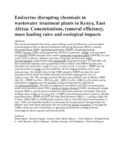| dc.contributor.author | Ngeno, Emily | |
| dc.contributor.author | Ongulu, Roselyn | |
| dc.contributor.author | Orata, Francis | |
| dc.contributor.author | Matovu, Henry | |
| dc.contributor.author | Shikuku, Victor | |
| dc.contributor.author | Onchiri, Richard | |
| dc.contributor.author | Mayaka, Abel | |
| dc.contributor.author | Majanga, Eunice | |
| dc.contributor.author | Getenga, Zachary | |
| dc.contributor.author | Gichumbi, Joel | |
| dc.date.accessioned | 2023-11-01T11:31:42Z | |
| dc.date.available | 2023-11-01T11:31:42Z | |
| dc.date.issued | 2023-11-01 | |
| dc.identifier.uri | https://doi.org/10.1016/j.envres.2023.117076 | |
| dc.identifier.uri | https://www.sciencedirect.com/science/article/abs/pii/S0013935123018807 | |
| dc.identifier.uri | http://ir-library.mmust.ac.ke:8080/xmlui/handle/123456789/2381 | |
| dc.description.abstract | This study investigated the levels, mass loadings, removal efficiency, and associated ecotoxicological risks of selected endocrine disrupting chemicals (EDCs), namely, dibutylphthalate (DBP), diethylhexylphthalate (DEHP), dimethylphthalate (DMP), linuron (LNR) and progesterone (PGT) in wastewater, sludge, and untreated dry biosolid (UDBS) samples from twelve wastewater treatment plants (WWTPs) in nine major towns in Kenya. Analysis was done using high-performance liquid chromatography coupled with triple quadrupole mass spectrometry (LC-MS/MS). All the wastewater influents had quantifiable levels of EDCs with DBP being the most abundant (37.49%) with a range of 4.33 ± 0.63 to 19.68 ± 1.24 μg L−1. DEHP was the most abundant in sludge and accounted for 48.2% ranging between 278.67 and 9243.49 ng g−1 dry weight (dw). In the UDBS samples, DEHP was also the most abundant (40%) of the total EDCs detected with levels ranging from 78.77 to 3938.54 ng g−1 dw. The average removal efficiency per pollutant was as follows: DMP (98.7%) > DEHP (91.7%) > PGT (83.4%) > DBP (77.9%) > LNR (72.2%) which can be attributed to sorption onto the biosolid, biological degradation, photolysis, and phytoremediation. The pH was negatively correlated to the EDC concentrations while total dissolved solids (TDS), chemical oxygen demand (COD), biochemical oxygen demand (BOD5), and electrical conductivity (EC) were positively correlated. The mass loadings were as high as 373.33 g day−1 of DBP in the treatment plants located in densely populated cities. DEHP and PGT had their Risk Quotients (RQs) > 1, posing a high risk to biota. DMP, DBP, and LNR posed medium risks as their RQ values were between 0.1 and 1. EDCs are therefore loaded to environmental compartments through either the effluent that loads these pollutants into the receiving aquatic ecosystem or through the UDBS, which are used as fertilizers in agricultural farmlands causing potential toxicological risks to aquatic and terrestrial life. | en_US |
| dc.language.iso | en | en_US |
| dc.publisher | Environmental Research | en_US |
| dc.subject | Endocrine, disrupting, chemicals, wastewater, treatment, plants, Kenya, East Africa, Concentrations, removal, efficiency, mass, loading, rates, ecological, impacts | en_US |
| dc.title | Endocrine disrupting chemicals in wastewater treatment plants in Kenya, East Africa: Concentrations, removal efficiency, mass loading rates and ecological impacts | en_US |
| dc.type | Article | en_US |

